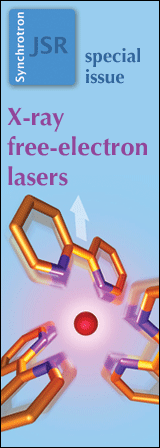about Journal of Synchrotron Radiation
Distribution of articles
In the last year, authors from 41 different countries published in the journal, the top five being Germany, China, the USA, the UK and France.
Aims and scope
Synchrotron radiation research is rapidly expanding with many new sources of radiation being created globally. Synchrotron radiation plays a leading role in pure science and in emerging technologies. Journal of Synchrotron Radiation is a fully open access journal and provides comprehensive coverage of the entire field of synchrotron radiation and X-ray free-electron laser (XFEL) research including:
- instrumentation and experimental development supported by validated results
- beamline construction and operation
- theory, software and data analysis
- machine learning and artificial intelligence
- scientific applications in areas such as physics, chemistry, biology and medicine, nanoscience, materials science, environmental science and cultural heritage
The journal accepts the following types of manuscripts:
- research articles: original research of significance appealing to the wide readership of the journal
- short communications: brief articles that present original material for rapid dissemination
- review articles: feature articles, lead articles and topical reviews giving a concise and critical review of research areas of interest to the general readership of the journal
- beamline articles: providing details of beamlines available to users at synchrotron and XFEL facilities around the world
- computer programs: describing the purpose, strategy, computer language, machine requirements, input requirements and type of results obtained
- teaching and education: covering all aspects of an educational nature related to the general field of synchrotron radiation
Publisher information
Publisher name: International Union of Crystallography (co-published with Wiley)
Publisher name: International Union of Crystallography
Organisational address: 5 Abbey Square, Chester CH1 2HU, England
Business structure: not-for-profit organisation
Organisation owner: the International Union of Crystallography is owned by the crystallographic community. It is governed by a General Assembly and an Executive Committee, see https://www.iucr.org/iucr/governance/ec
General information
Title: Journal of Synchrotron Radiation
Abbreviated title: J. Synchrotron Rad.
ISSN: 1600-5775
CODEN: JSYRES
DOI: https://doi.org/10.1107/S16005775
Publication frequency: bimonthly
Citation and statistical information
Impact factor history
2024 JCR data
Impact factor: 3
Journal citation indicator: 0.76
5-year impact factor: 2.8
Total cites: 8487
Immediacy index: 0.7
Cited half-life: 9.4 years
Journal citation distribution
The citation distributions are for citations made in 2022 and 2023. For more information, see https://biorxiv.org/content/early/2016/09/11/062109.
Eigenfactor® metrics
Eigenfactor® score: 0.00638
Article influence® score: 0.859
Scopus metrics
CiteScore: 5.4
2024 journal statistics
Downloads: 2129493
Number of submissions: 283
Acceptance rate: 69%
Average publication time: 4.8 months
Number of articles published: 175
Number of pages: 1626
Peer review
Peer review process
Peer review: yes
Review process: single-blind
Number of reviews requested: 867
Number of reviews received: 379
Open access
Journal policy: the journal is open access
Open-access licence: Creative Commons Attribution (CC-BY 4.0 International)
Date of change to open access: 1 January 2022
Availability of archive material: material published before 2022 is freely available
Publishing costs
Submission fees: none
Page charges: none
Colour charges: none
Open-access fees: the open-access fee is from USD 2290; click here for more details
Abstracting details
Journal of Synchrotron Radiation is covered by:
- Ceramic Abstracts
- Chemical Abstracts
- Crossref
- Cambridge Structural Database
- Engineered Materials Abstracts
- Google Scholar
- Inorganic Crystal Structure Database
- INIS
- INSPEC
- Medline
- Metals Abstracts/METADEX
- PubMed Central
- Science Citation Index
- Science Citation Index Expanded
- SCISEARCH
- Scopus
Features for authors
- Online manuscript submission, ease of submission
- WORD and LaTeX templates available
- Online tools to help prepare papers
- Quality technical editing
- Supporting information can be published
- Online status check facility
- Article publicity
- Download, citation and altmetrics statistics available
Features for readers
- E-mail alerting (sign up, update your settings, unsubscribe)
- RSS feeds
- Forthcoming articles listing
- Highlighted articles
- Open-access articles
- Online access to all articles back to the first issue
- Full text, article title, keyword, abstract/synopsis and author searching
- Links to World Directory of Crystallographers entries
- Easy navigation within each article
- Citation links to IUCr journals, Chemical Abstracts Service, Crossref, Medline and Web of Science
- Immediate access to supporting information
- Interactive three-dimensional structure visualizations
- Linking to structural databases
- Hyperlinks to IUCr Online Dictionary of Crystallography and IUPAC Gold Book
- Check for citations of article in Web of Science, IUCr journals and Crossref
- Forthcoming meetings listing
- Twitter feed
- Facebook page
- Sample issue available
Advertising information
Journal policies
- Editorial policies
- Article correction and retraction policy
- Ethics
- Author rights
- Copyright and licencing policy
- NIH public access policy
- Permissions requests
Contact us
- Editorial board contact details
- Editorial office contact details
- Contact us by web
- See us at meetings
- How to find our offices
Diversity and inclusion
We affirm that all aspects of the publication process, as well as the research undertaken in support of publication, should be conducted in such a way as to maximize inclusion and diversity in all its forms, wherever possible.

 journal menu
journal menu




